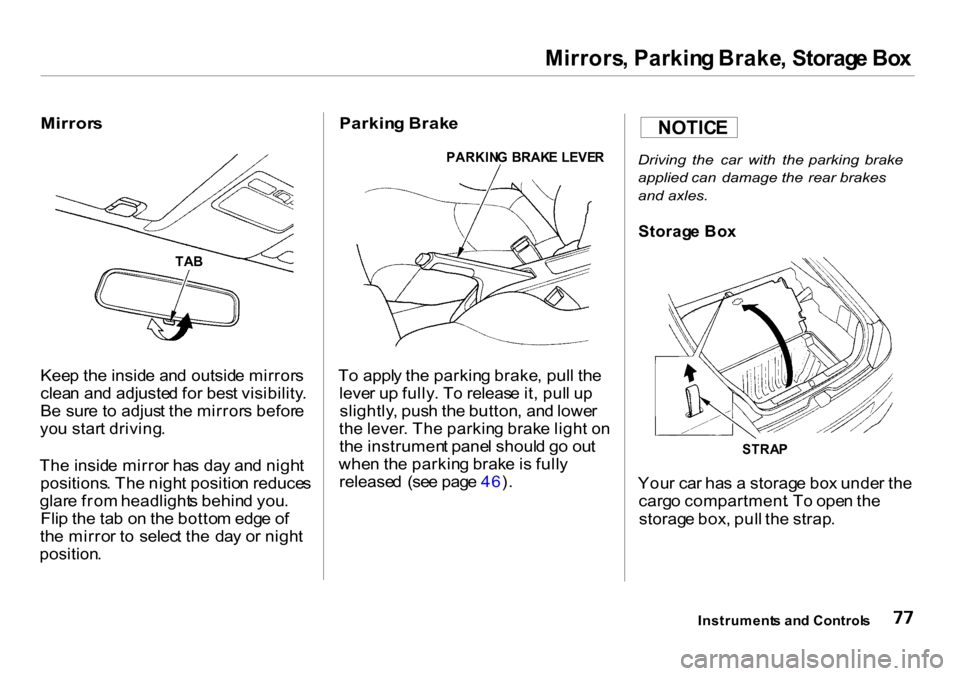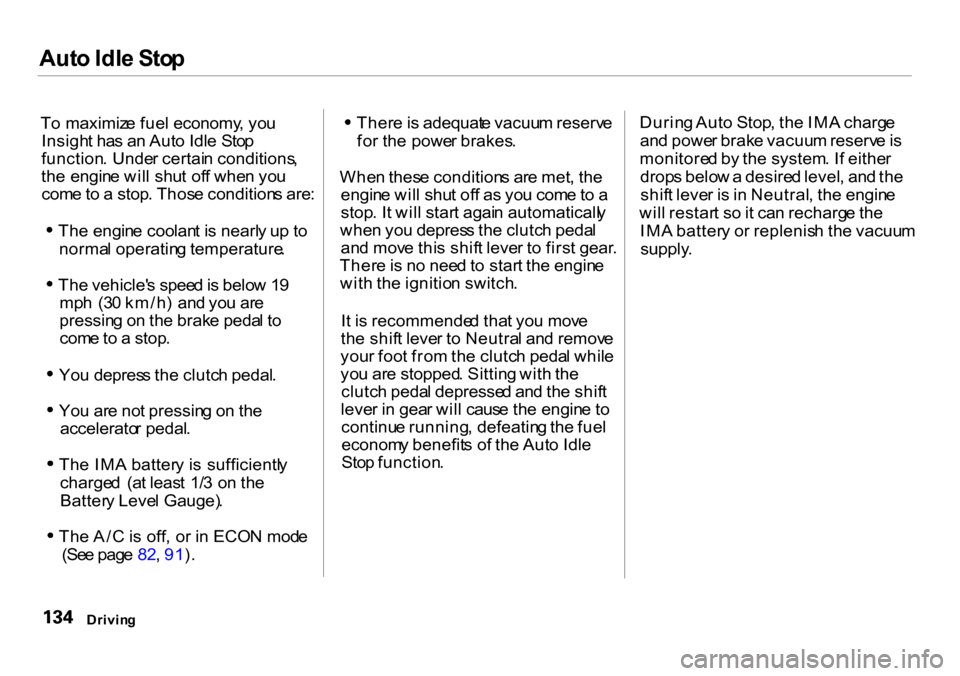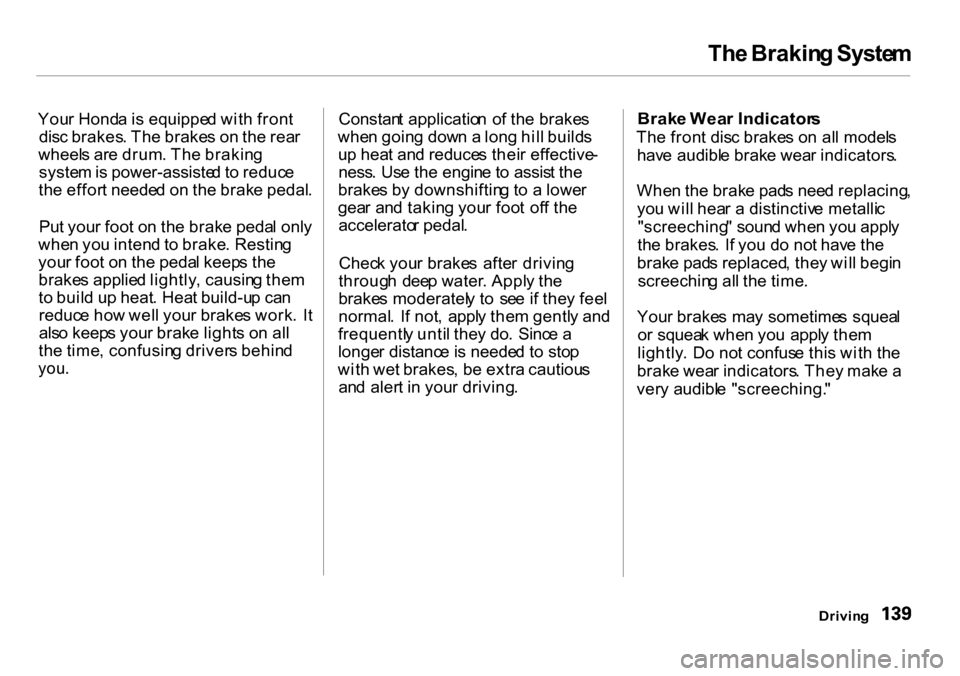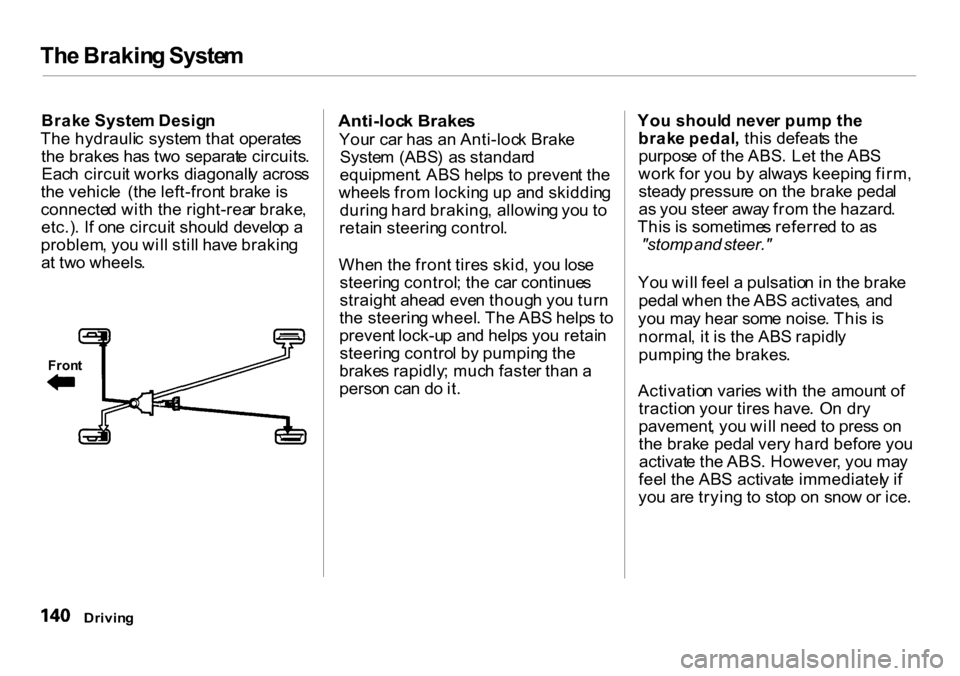2000 HONDA INSIGHT brakes
[x] Cancel search: brakesPage 80 of 262

Mirrors, Parkin g Brake , Storag e Bo x
Mirror s
Keep th e insid e an d outsid e mirror s
clea n an d adjuste d fo r bes t visibility .
B e sur e t o adjus t th e mirror s befor e
yo u star t driving .
Th e insid e mirro r ha s da y an d nigh t
positions . Th e nigh t positio n reduce s
glar e fro m headlight s behin d you .
Fli p th e ta b o n th e botto m edg e o f
th e mirro r t o selec t th e da y o r nigh t
position .
Parking Brak e
To appl y th e parkin g brake , pul l th e
leve r u p fully . T o releas e it , pul l u p
slightly , pus h th e button , an d lowe r
th e lever . Th e parkin g brak e ligh t o n
th e instrumen t pane l shoul d g o ou t
whe n th e parkin g brak e is full y
release d (se e pag e 46 ).
Driving the car with the parking brake
applied can damage the rear brakes
and axles.
You r ca r ha s a storag e bo x unde r th e
carg o compartment . T o ope n th e
storag e box , pul l th e strap .
Instrument s an d Control s
TAB PARKIN
G BRAK E LEVE R
STRAP
Storag e Bo x
NOTIC E
Page 134 of 262

Drivin
g
Thi s sectio n give s yo u tip s o n
startin g th e engin e unde r variou s
conditions , an d ho w to operat e th e
manua l transmission . I t als o include s
importan t informatio n o n parkin g
you r car , an d th e brakin g system . Preparin
g to Drive........................ . 13 2
Startin g th e Engine....................... . 13 3
Startin g in Col d Weathe r
a t Hig h Altitude.................... . 13 3
Aut o Idl e Stop................................ . 13 4
5-spee d Manua l Transmission.... . 13 6
Shif t Up/Shif t Dow n
Indicators............................... . 13 7
Engin e Spee d Limiter.............. . 13 7
Parking........................................... . 13 8
Parkin g Tips.............................. . 13 8
Th e Brakin g System..................... . 13 9
Brak e Wea r Indicators............. . 13 9
Brak e Syste m Design............... . 14 0
Anti-loc k Brakes....................... . 14 0
Drivin g in Ba d Weather............... . 14 2
Towin g a Trailer........................... . 14 3
Drivin g
Page 137 of 262

Aut
o Idl e Sto p
T o maximiz e fue l economy , yo u
Insigh t ha s a n Aut o Idl e Sto p
function . Unde r certai n conditions ,
th e engin e wil l shu t of f whe n yo u
com e to a stop . Thos e condition s are :
Th e engin e coolan t i s nearl y u p to
norma l operatin g temperature .
Th e vehicle' s spee d is belo w 1 9
mp h (3 0 km/h ) an d yo u ar e
pressin g o n th e brak e peda l t o
com e to a stop .
Yo u depres s th e clutc h pedal .
Yo u ar e no t pressin g o n th e
accelerato r pedal .
Th e IM A batter y i s sufficientl y
charge d (a t leas t 1/ 3 o n th e
Batter y Leve l Gauge) .
Th e A/ C is off , o r i n ECO N mod e
(Se e pag e 82 , 91 ). Ther
e is adequat e vacuu m reserv e
fo r th e powe r brakes .
Whe n thes e condition s ar e met , th e
engin e wil l shu t of f a s yo u com e to a
stop . I t wil l star t agai n automaticall y
whe n yo u depres s th e clutc h peda l
an d mov e thi s shif t leve r t o firs t gear .
Ther e is n o nee d to star t th e engin e
wit h th e ignitio n switch .
I t i s recommende d tha t yo u mov e
th e shif t leve r t o Neutra l an d remov e
you r foo t fro m th e clutc h peda l whil e
yo u ar e stopped . Sittin g wit h th e
clutc h peda l depresse d an d th e shif t
leve r i n gea r wil l caus e th e engin e to
continu e running , defeatin g th e fue l
econom y benefit s o f th e Aut o Idl e
Sto p function .
Durin
g Aut o Stop , th e IM A charg e
an d powe r brak e vacuu m reserv e is
monitore d b y th e system . I f eithe r
drop s belo w a desire d level , an d th e
shif t leve r i s in Neutral , th e engin e
wil l restar t s o it ca n recharg e th e
IM A batter y o r replenis h th e vacuu m
supply .
Drivin g
Page 141 of 262

Parkin
g
Alway s us e th e parkin g brak e whe n
yo u par k you r car . Th e indicato r o n
th e instrumen t pane l show s tha t th e
parkin g brak e is no t full y released ; i t
doe s no t indicat e tha t th e parkin g
brak e is firml y set . Mak e sur e th e
parkin g brak e is se t firml y o r you r
ca r ma y rol l i f i t i s parke d o n a n
incline . I
f th e ca r i s facin g uphill , tur n th e
fron t wheel s awa y fro m th e cur b an d
pu t th e transmissio n in firs t gear .
I f th e ca r i s facin g downhill , tur n th e
fron t wheel s towar d th e cur b an d pu t
th e transmissio n in revers e gear .
Mak e sur e th e parkin g brak e is full y
release d befor e drivin g away .
Drivin g wit h th e parkin g brak e
partiall y se t ca n overhea t o r damag e
th e rea r brakes . Parkin
g Tip s Mak
e sur e th e window s ar e closed .
Tur n of f th e lights .
Plac e an y packages , valuables , etc. ,
i n th e storag e bo x o r tak e the m
wit h you .
Loc k th e doors .
Neve r par k ove r dr y leaves , tal l
grass , o r othe r flammabl e
materials . Th e thre e wa y catalyti c
converte r get s ver y hot , an d coul d
caus e thes e material s t o catc h o n
fire .
Drivin g
Page 142 of 262

Th
e Brakin g Syste m
You r Hond a is equippe d wit h fron t
dis c brakes . Th e brake s o n th e rea r
wheel s ar e drum . Th e brakin g
syste m is power-assiste d to reduc e
th e effor t neede d o n th e brak e pedal .
Pu t you r foo t o n th e brak e peda l onl y
whe n yo u inten d to brake . Restin g
you r foo t o n th e peda l keep s th e
brake s applie d lightly , causin g the m
t o buil d u p heat . Hea t build-u p ca n
reduc e ho w wel l you r brake s work . I t
als o keep s you r brak e light s o n al l
th e time , confusin g driver s behin d
you .
Constan
t applicatio n o f th e brake s
whe n goin g dow n a lon g hil l build s
u p hea t an d reduce s thei r effective -
ness . Us e th e engin e t o assis t th e
brake s b y downshiftin g t o a lowe r
gea r an d takin g you r foo t of f th e
accelerato r pedal .
Chec k you r brake s afte r drivin g
throug h dee p water . Appl y th e
brake s moderatel y t o se e i f the y fee l
normal . I f not , appl y the m gentl y an d
frequentl y unti l the y do . Sinc e a
longe r distanc e is neede d t o sto p
wit h we t brakes , b e extr a cautiou s
an d aler t i n you r driving .
Brak
e Wea r Indicator s
Th e fron t dis c brake s o n al l model s
hav e audibl e brak e wea r indicators .
Whe n th e brak e pad s nee d replacing ,
yo u wil l hea r a distinctiv e metalli c
"screeching " soun d whe n yo u appl y
th e brakes . I f yo u d o no t hav e th e
brak e pad s replaced , the y wil l begi n
screechin g al l th e time .
You r brake s ma y sometime s squea l
o r squea k whe n yo u appl y the m
lightly . D o no t confus e thi s wit h th e
brak e wea r indicators . The y mak e a
ver y audibl e "screeching. "
Drivin g
Page 143 of 262

Th
e Brakin g Syste m
Brak e Syste m Desig n
Th e hydrauli c syste m tha t operate s
th e brake s ha s tw o separat e circuits .
Eac h circui t work s diagonall y acros s
th e vehicl e (th e left-fron t brak e i s
connecte d wit h th e right-rea r brake ,
etc.) . I f on e circui t shoul d develo p a
problem , yo u wil l stil l hav e brakin g
a t tw o wheels .
Anti-loc
k Brake s
You r ca r ha s a n Anti-loc k Brak e
Syste m (ABS ) a s standar d
equipment . AB S help s t o preven t th e
wheel s fro m lockin g u p an d skiddin g
durin g har d braking , allowin g yo u t o
retai n steerin g control .
Whe n th e fron t tire s skid , yo u los e
steerin g control ; th e ca r continue s
straigh t ahea d eve n thoug h yo u tur n
th e steerin g wheel . Th e AB S help s t o
preven t lock-u p an d help s yo u retai n
steerin g contro l b y pumpin g th e
brake s rapidly ; muc h faste r tha n a
perso n ca n d o it . Yo
u shoul d neve r pum p th e
brak e pedal , thi s defeat s th e
purpos e o f th e ABS . Le t th e AB S
wor k fo r yo u b y alway s keepin g firm ,
stead y pressur e o n th e brak e peda l
a s yo u stee r awa y fro m th e hazard .
Thi s i s sometime s referre d t o a s
"stomp and steer."
Yo u wil l fee l a pulsatio n i n th e brak e
peda l whe n th e AB S activates , an d
yo u ma y hea r som e noise . Thi s i s
normal , i t i s th e AB S rapidl y
pumpin g th e brakes .
Activatio n varie s wit h th e amoun t o f
tractio n you r tire s have . O n dr y
pavement , yo u wil l nee d t o pres s o n
th e brak e peda l ver y har d befor e yo u
activat e th e ABS . However , yo u ma y
fee l th e AB S activat e immediatel y i f
yo u ar e tryin g t o sto p o n sno w o r ice .
Drivin g
Fron
t
Page 151 of 262

Maintenanc
e Schedul e
Th e Maintenanc e Schedul e specifie s
ho w ofte n yo u shoul d hav e you r ca r
service d an d wha t thing s nee d
attention . I t i s essentia l tha t yo u hav e
you r ca r service d a s schedule d to
retai n it s hig h leve l o f safety ,
dependability , an d emission s contro l
performance .
Th
e service s an d tim e o r distanc e
interval s show n in th e maintenanc e
schedul e assum e yo u wil l us e you r
ca r a s norma l transportatio n fo r
passenger s an d thei r possessions .
Yo u shoul d als o follo w thes e
recommendations :
Avoi d exceedin g you r car' s loa d
limit . Thi s put s exces s stres s o n
th e engine , brakes , an d man y
othe r part s o f you r car . Th e loa d
limi t i s show n o n th e labe l o n th e
driver' s doorjamb .
Operat e you r ca r o n reasonabl e
road s withi n th e lega l spee d limit .
Driv e you r ca r regularl y ove r a
distanc e o f severa l mile s
(kilometers) .
Alway s us e unleade d gasolin e wit h
th e prope r octan e ratin g (se e pag e
118 ). Whic
h Schedul e t o Follow :
Servic e you r ca r accordin g to th e
tim e an d mileag e period s o n on e o f
th e Maintenanc e Schedule s o n th e
followin g pages . Selec t th e schedul e
fo r "Sever e Conditions " i f mos t o f
you r drivin g is don e unde r on e o r
mor e o f th e condition s liste d o n tha t
page . Otherwise , follo w th e schedul e
fo r "Norma l Conditions. "
Maintenanc e